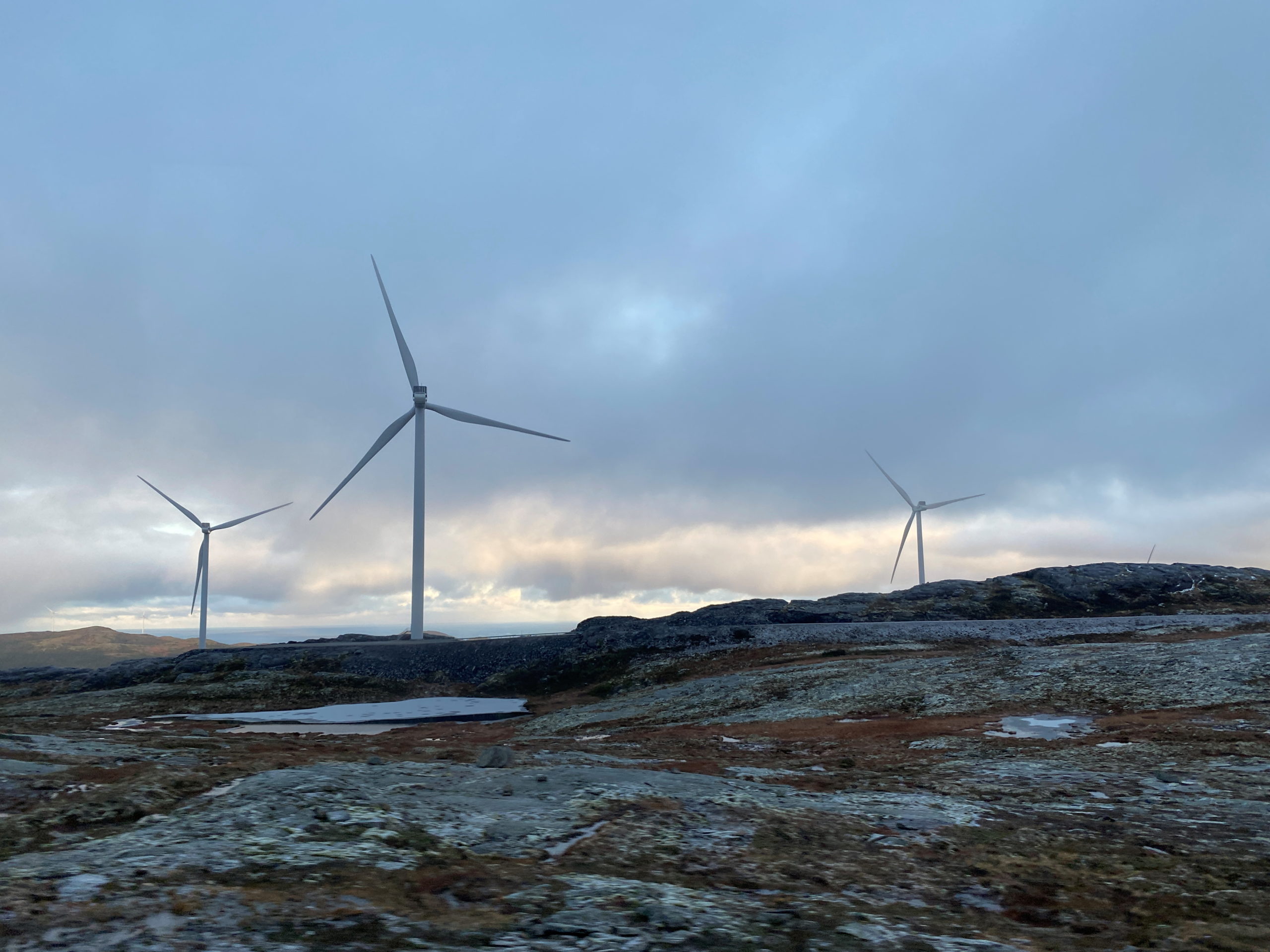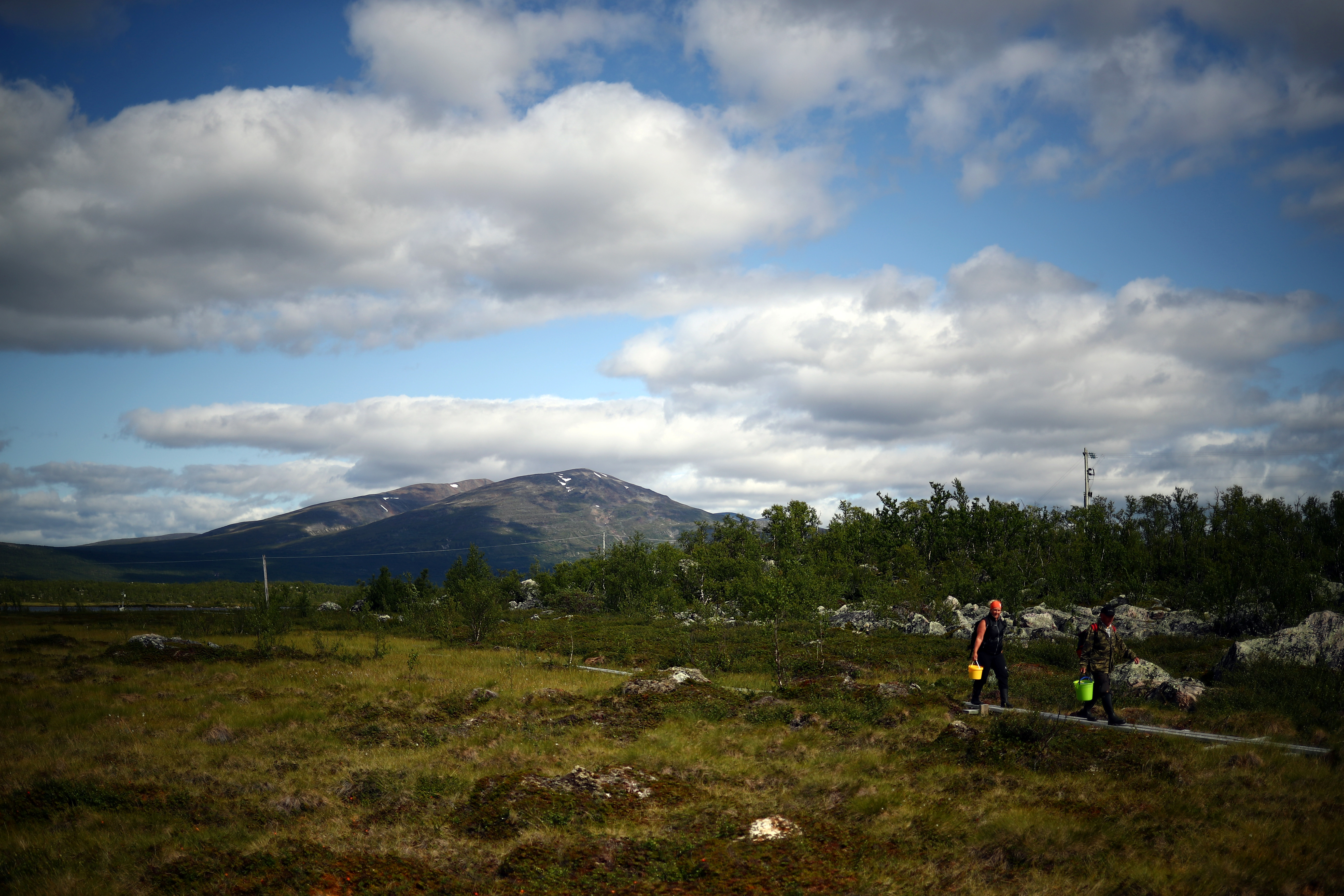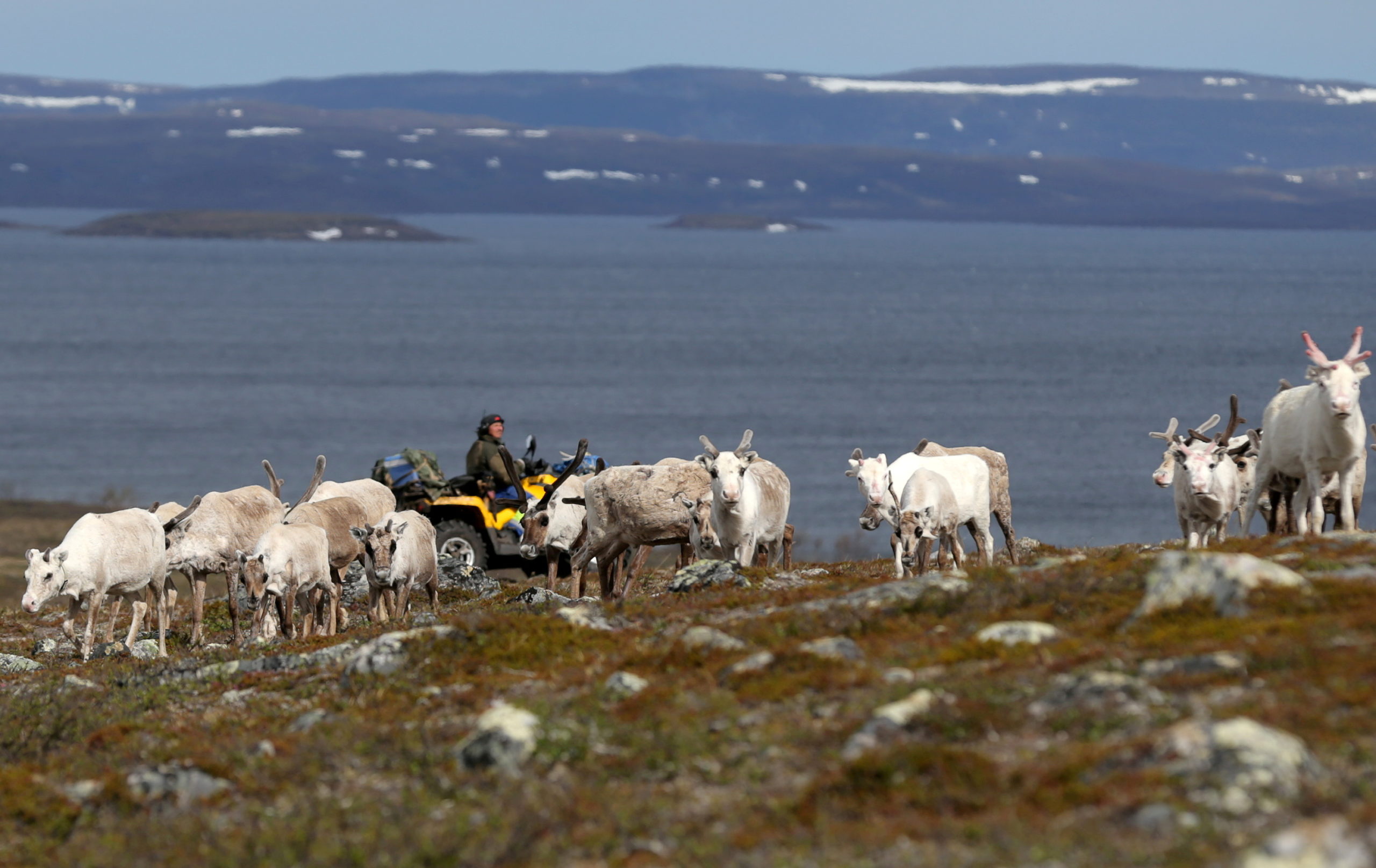Indigenous cultures must not be forced to bear the brunt of global climate adaptation
Forcing already endangered cultures to accept disruptive activities in the name of mitigating climate change amounts to a new form of colonialism.

As I write this, I am sitting by Várjjatvuotna; this is the name for Varangerfjord in my native Sámi language, once the only language spoken here. The sun is still below the horizon, but it casts a strong orange light in a strip between the mountains in the south and the dark clouds. It is January, and the temperature fluctuates between minus 20 degrees Celsius one moment and zero the next. When I was growing up in the 1970s, freezing cold was common at this time.
Recently, the Norwegian national broadcaster, NRK, presented a climate scenario for the year 2100. The scenario shows that my municipality, Unjárga – Nesseby (located at 70 degrees North), tops the list of places in Norway that can expect the most warming in the next 80 years. The area we live in, the only actual Arctic area in mainland Norway — is predicted to have the same climate in 2100 that Sogndal located in western Norway at 61 degrees North some 1,400 kilometers southeast, has today. How will that affect our livelihoods, our harvesting culture, our knowledge and language?
When I wander with my mother on the homelands of our people, she constantly talks about the land around us while we are walking, passing on the knowledge she heard from her mother and aunt. She talks about the weather conditions last spring and reasons where the berries are most likely to be found — and where there probably are no berries. In good cloudberry years, the trips with my family on the Varanger Peninsula can extend over several days.
One night we sat together around the fire. I asked my mother about the plans for the next day, in order to understand how she thinks about berry picking.
“Today we have spent the whole day picking cloudberries east of the campsite and mostly south of the lake. Where do you think we should be going tomorrow?” I asked. “Well,” she replied, and began to reason: “since there have been such strong easterly winds in early summer, there are probably not so many berries on the open bogs, but there are usually berries in the thicket on the northwest side of the lake, there the blossoms have probably been sheltered from the winds. There are often a lot of berries right there, they are big, too.” Then she interrupted herself, looked up at the clear sky and added: “Na, jos ieš ii čokkeš vuos”. It is Northern Sami, and can be translated as, “if he/she is not picking the berries him/herself” (Sámi language does not distinguish between genders in personal pronouns). She referred to the clear sky which already in August can warn of frost during the night, which would spoil the cloudberries.
This is not the first time I heard this kind of phrasing in the Sámi language. A reservation is always present. It is a recognition of the powers beyond one’s own power, powers you must have with you if you are to be lucky enough to get a good harvest. This is a worldview and knowledge that is passed down from generation to generation through customary use and belonging, faith and belief. We call it árbediehtu — Indigenous knowledge.

In his master’s thesis “Bivdit Luosa” – To Ask for Salmon, Sami scholar Aslak Holmberg writes about the young salmon fisherman Áslat. Áslat has learned from the elderly that guolli galgá bistit suddásis suddásii – the salmon you catch should last from the time the river freezes until it opens again. If you have salmon left, which you caught last summer, when a new fishing season begins, then fishing luck will not stand with you. Then you either have taken too much fish, or you have shared too little. To fish for salmon is in Northern Sami “bivdit luosa,” but the word “bivdit” can also mean to ask for salmon. A key lesson in Sámi culture is that you should not ask for more than you need.
Reindeer herder Elle Merete was given her own calf and her own reindeer mark when she was six years old. “It was the proudest moment in my life,” she says. ‘I got the reindeer earmark that mirrored the one of my aahka – grandmother. This has created a strong relationship and a special and strong community between aahka and me. When I marked my first calf in my own reindeer mark, I knew that this calf and the herd that would come from it over time would be my responsibility. I learned its colors, its qualities and of course reading and cutting my earmark. It was my responsibility that the calf became a good reindeer, that it had good food and was safe from danger in the reindeer grazing area, so that it would continue to provide our family with a livelihood.
It is not easy to put árbediehtu — Indigenous peoples’ knowledge — into words. It is a distinctive knowledge system, an understanding that is deep and complex. The Norwegian Biodiversity Act calls it “experience-based knowledge.” Some call it “silent knowledge” because it is not written down and can be perceived as pure intuition. It could also be called “silenced knowledge” because it has been marginalized by centuries of missionary work and “Norwegianization” which has led to this knowledge being seen as inferior. Loss of knowledge is a painful loss for a people.
Indigenous knowledge is a systematic way of thinking and knowing that is elaborated and applied to phenomena across biological, physical, cultural and linguistic systems. Indigenous knowledge is owned by the holders of that knowledge, often collectively, and is best expressed and transmitted through Indigenous languages. It is a body of knowledge generated through cultural practices, lived experiences, extensive and multi-generational observations, lessons and skills.
It has been developed and verified over millennia and is still developing as a living process, including knowledge acquired today and in the future, and it is passed on from generation to generation. In the last few years, the value of Indigenous knowledge has gained more official recognition. It is seen in the Convention on Biological Diversity, the Paris Agreement on Climate Change, and in the last two reports of the Intergovernmental Panel on Climate Change.
But how does this knowledge function when the places that generated it become different places?
According to NRK, the climate in Unjárga (or Nesseby) in 80 years is likely to be similar to today’s Sogndal. You can try to imagine it: Do cloudberries grow in Sogndal? Are there a lot of ticks in Sogndal? Do they carry diseases foreign to Unjárga? What will it be like to raise reindeer in a climate like Sognefjord’s? Today, reindeer husbandry is conducted in areas in the world where there is snow part of the year, because the reindeer and the people who follow the reindeer are adapted to manage in snow conditions parts of the year.
Sápmi has been the home of Sámi since time immemorial. It spans the northern parts of Norway, Sweden and Finland, and Russia’s Kola Peninsula, an area that is considered both Arctic and sub-Arctic. Here, the climate is changing two to three times faster than the global average. Globally, the discussion is about limiting climate change to 1.5 degrees Celsius, but in Arctic areas, that would be 3 to 4.5 degrees C. Commitments agreed to so far will not hit the 1.5-degree target, but rather 2 degrees or more, so in the Arctic a 4 to 6 degrees increase can be expected. It is not mainly the summers that are projected to get hotter; it is the winters. And they’re projected to get wetter too.
We already know a great deal about the impacts of climate change. We know that in Sámi areas we can expect a longer growing season, an earlier spring and later winter, which will lead to changes in the flora. The tree line will climb to higher altitudes,the forest will spread, and other species may take over from those we know in the area today. We will see overgrowth and more dense scrub, which also contributes to more of the previously white surface in winter becoming dark, which will feedback amplification of warming. The wetter climate can lead to better conditions for other plant species than those that are there today, and they will be able to displace the typical Arctic flora.
These factors can attract new types of insects and parasites, which can damage existing flora. Moth larvae have already caused immense damage to the dominant birch forests of northern Norway. An increase in parasites living on reindeer will affect animal welfare and human health. New and foreign insects can be bothersome to both animals and people, and in the worst case bring with them new diseases. We have also seen examples of early and dry springs that are out of step with insect pollination. Milder winters, where the temperature more often fluctuates around thawing and freezing, lead to icing of pastures and it becomes difficult for the reindeer to get to their food under snow and ice. When the sea temperature rises, today’s fish species will seek colder waters and new species will come to the coast and into the fjords. Warmer seas will also lead to ocean acidification. This will affect shellfish and fish fry and their growing conditions. The fishermen report changes in wind directions and stronger winds. Climate research does not say much about this but for fishermen it means more days on shore. Recently, heath and forest fires have also occurred in the southernmost areas of Sápmi. These current and future changes undermine the nature and resource foundation of Sámi culture. Species that sustain us in the Sámi food culture and in the Sámi handicraft (duodji) tradition disappear or deteriorate in quality.

Sámi livelihoods have good competence in dealing with changes — in nature-based industries, people deal with changing conditions in weather, wind, and surroundings all the time. If the pastures are locked by ice in the winter, then you have to lead the herd to alternative areas where they may access the pasture. In the worst case, they must be fed. If bogs, rivers, and lakes open up earlier in the spring, the reindeer herd must be led on alternative routes on their migration to the summer grazing. The female reindeer needs peace when it arrives at the place where it will give birth to its calf. During the height of summer the reindeer need their windy high-lying areas to get away from bothersome insects. This has been learned through generations.
It is the diversity of resources that is the foundation for life. Changing conditions and changing access to resources have taught us that one cannot be dependent on a single resource, such as cod, as in the case of the Sámi by the coast and in the fjords. When the cod fishery failed, the entire economic base did not collapse. Instead, it has been established that if something is wrong in the fjord, the fishing activity rests for a while and one moves on to harvest another resource on land or take a larger share of paid work. This is the essence of mixed economies. Flexibility is the key to survival in harsh climatic conditions.
It is life in the fjord that is the foundation for life in Sámi fjord areas — and it has been so for more than 10,000 years. A culture built around alternating use and flexibility and based on a diversity of resources will be less vulnerable to climate change than a culture that bases its livelihood on harvesting a single resource. If the culture stands strong, and one is able to control one’s own adaptation measures, and if other external stressors and pressures are kept at the minimum — then the people of that culture possess an ability to adapt to the prevailing conditions at any given time. Gal mii birget — we will cope — we often say. In the daily struggle to adapt to the changes in the natural environment, there may not be much time to mourn the changes you see.
The largest immediate threat to Sámi culture and to reindeer husbandry in particular might not be climate change per se, but the authorities’ mitigating measures intended to reduce carbon dioxide emissions — let’s say the secondary effects of climate change. You need to look for alternative energy sources for coal, oil and gas. Giant wind turbines are best located far away from urban areas and therefore granted a license mainly in existing reindeer-grazing areas. Wind turbines represent major nature destruction, with associated roads and power grids to transport energy to the market. Today’s turbines are enormous and the low sun in the north means that the turbines cast long moving shadows. A turbine does not only take the piece of land it is on.
Last month, Norway’s Supreme Court granted Sámi a victory when it revoked the licenses of two wind farms in grazing areas. Still, though herders now press for their removal, the Norwegian government hadn’t committed to tearing them down by the time this was published.
The mainstream society’s shift from fossil fuels to more environmentally friendly driving — with electric cars, electric ferries, electric buses, and electric bicycles stimulates the immense need for development of batteries. This requires minerals, including copper from mines found in Sámi areas. Not small mines, which were seen in the area a hundred years ago, but large mining facilities that require large areas. They require more roads, power lines, and permission to dispose of toxic tailings on the seafloor in the fjord. Mines also contribute to the fragmentation of intact land. The authorities knowingly and willingly sacrifice the productive fjord systems for jobs, economic growth and more climate-friendly driving – rather than simply driving less.
At the same time, corporations and governments are looking to the Arctic for new opportunities. New sailing routes are opening for increasingly regular shipping through the Arctic, and the Russian Federation is promoting destinations along the Northern Sea Route. More shipping traffic combined with the idea of a railway from the coastal town of Kirkenes in northeast Norway to the end of the present railway in Finland will open up a sea and land of opportunities to extract and transport resources directly out to the market (though this project is now on hold). These developments would lead to enormous encroachment on infrastructure-free areas, presently used for reindeer husbandry, on both the Finnish and Norwegian sides of the border.
Climate change is leading to a massive change in the way Sámi land is used. Sápmi continues to be a source of resources targeted by governments and outside capital.. The green shift is nothing more than a continued extraction of resources in Sámi areas, as has been the tradition since the earliest encounters between cultures. The difference is that resource utilization has been given a nice color, green; we call it “green colonization.” We were first colonized by people from outside our lands, then colonized by climate change itself, driven by people from outside our lands, and are now being colonized a third time by responses to climate change.
The Sámi people are standing up against this continued colonization. It will lead to Sami culture balancing on the verge of extinction in many areas. Reindeer husbandry and small-scale fisheries need more flexibility to adapt their activities, not less flexibility, which are the consequences of the green shift. At the same time, the business community still lives by the principle of seeking continuous economic growth, economies that are built on people’s ever-increasing consumption patterns. Are not far more resources taken out than you strictly need to survive, and also live? It is a paradox that the only ones who are met with demands for reduction from the authorities are reindeer husbandry and traditional sea salmon fishermen.
The Sámi are among those who contribute the least to what leads to climate change, yet we are among the first to be affected by the changes. Our industries are among the first to be affected by climate change, then we are affected again by society’s measures to mitigate climate change. The same goes for Indigenous peoples around the world. It is an obvious injustice that those who have the greatest consumption of fossil fuels, and thus also have the greatest need for climate-friendly infrastructure, impose on people and areas with the least responsibility for greenhouse gas emissions the greatest burdens of land loss and reduction in culture-bearing occupations. We must see a more equitable distribution of the burdens where society at large takes a greater share of the responsibility. We expect climate justice. We will take our share of responsibility and ensure good and healthy food, but the Sámi people can not bear the heaviest burden for society’s need for a green shift.
Gunn-Britt Retter is head of the Arctic and Environmental Unit of the Saami Council. Earlier versions of this essay have been previously published in the book “Det går til helvete. Eller?” and in the Norwegian newspaper Morgenbladet.
The views expressed here are the writer’s and are not necessarily endorsed by ArcticToday, which welcomes a broad range of viewpoints. To submit a piece for consideration, email commentary (at) arctictoday.com.